Critical Analysis of Business Integration: Value Chain Analysis Report
VerifiedAdded on 2021/12/11
|8
|2263
|44
Report
AI Summary
This report provides a critical analysis of business integration, focusing on value chain analysis. It examines the value chain activities of two major Australian companies, Coles and Woolworths, including inbound logistics, operations, outbound logistics, marketing and sales, and services, as well as support activities like technology and human resources. The report highlights how these companies leverage their value chains to create competitive advantages. Furthermore, it offers recommendations for a fictitious small business (SME) in the retail sector, suggesting strategies such as integrating IT in supply chain activities, sourcing locally, streamlining operations with IT solutions, and using IT for employee training and development to gain a competitive edge in the market. The report concludes that effective value chain analysis and the integration of IT are crucial for improving business efficiency and achieving competitive advantage.
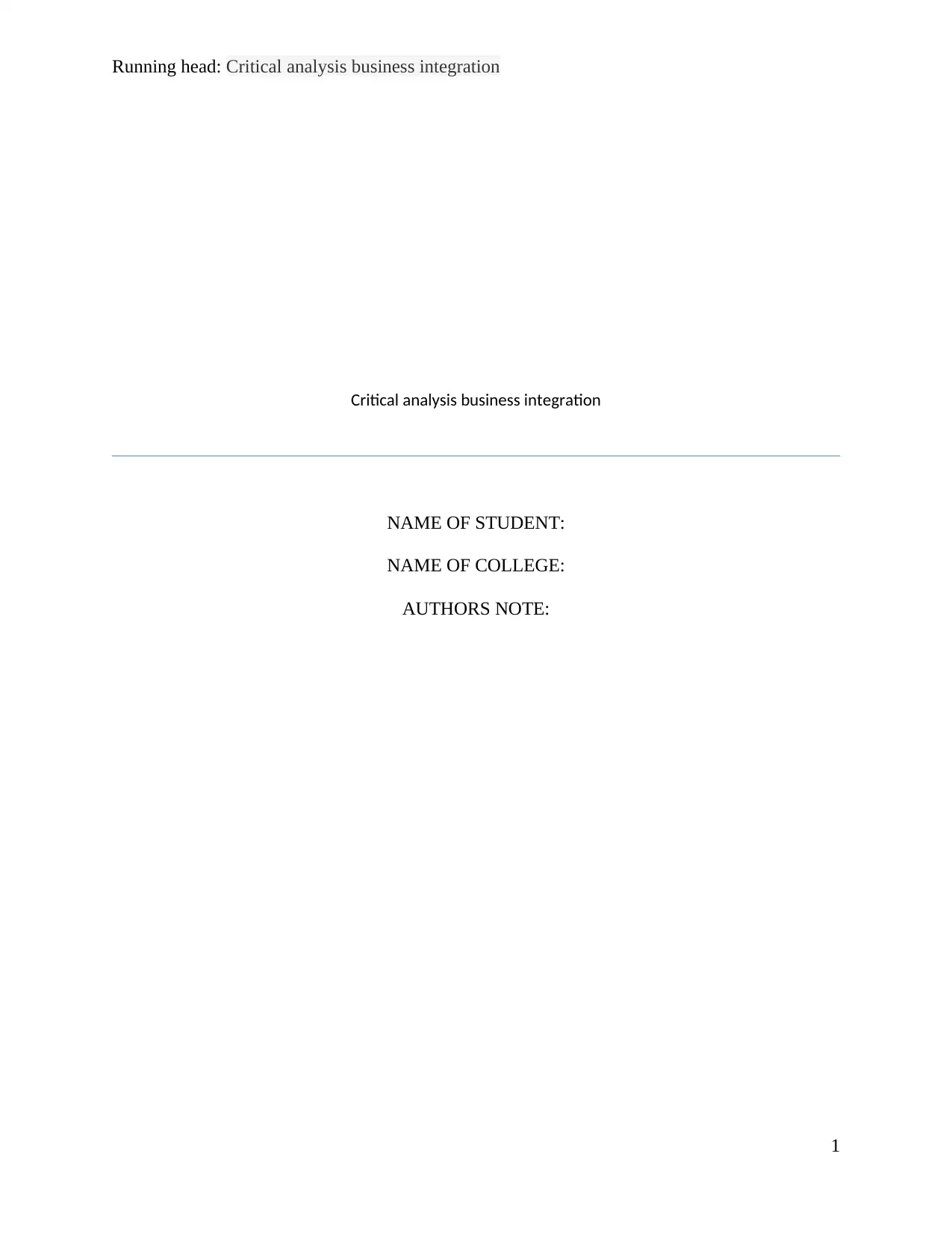
Running head: Critical analysis business integration
Critical analysis business integration
NAME OF STUDENT:
NAME OF COLLEGE:
AUTHORS NOTE:
1
Critical analysis business integration
NAME OF STUDENT:
NAME OF COLLEGE:
AUTHORS NOTE:
1
Paraphrase This Document
Need a fresh take? Get an instant paraphrase of this document with our AI Paraphraser
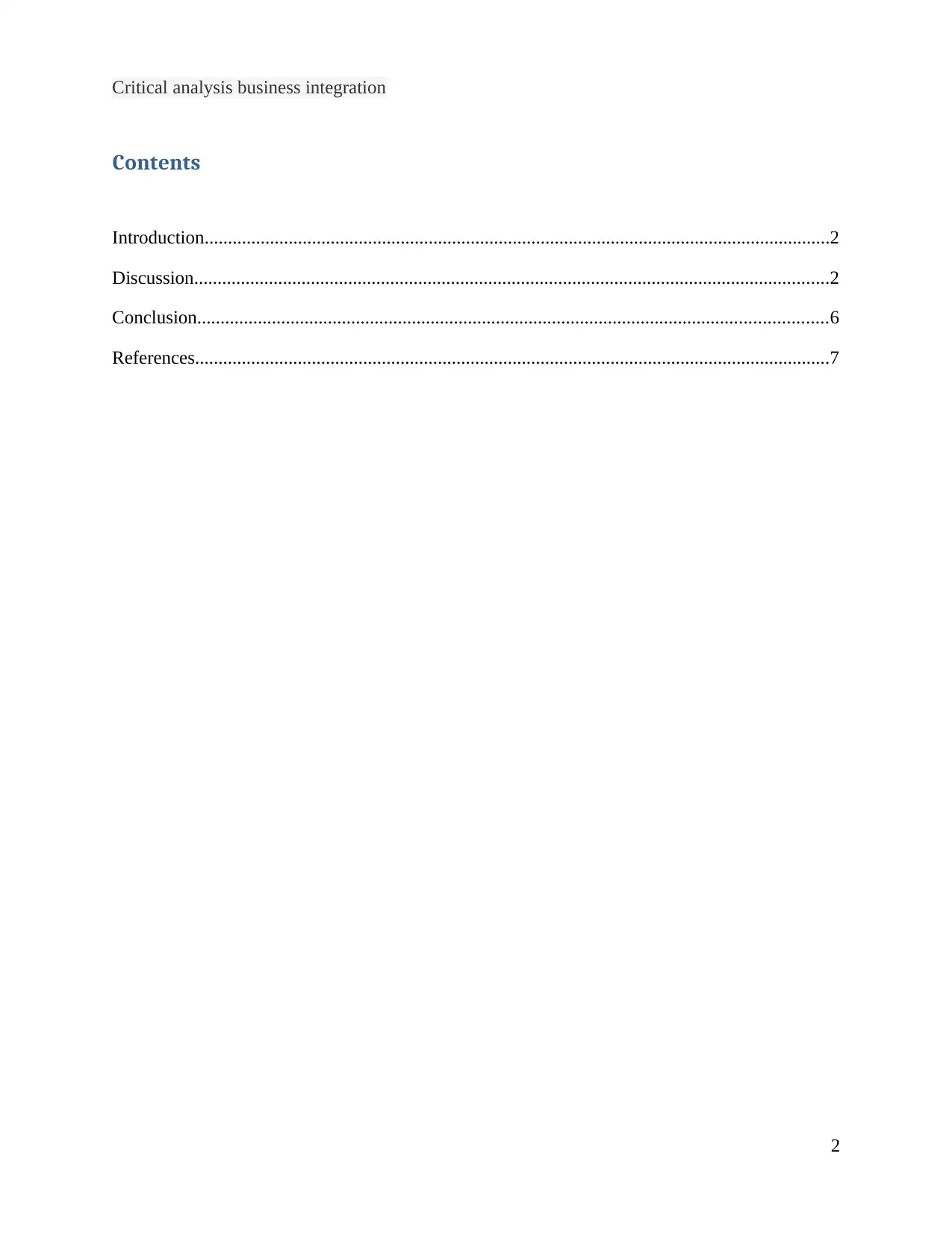
Critical analysis business integration
Contents
Introduction......................................................................................................................................2
Discussion........................................................................................................................................2
Conclusion.......................................................................................................................................6
References........................................................................................................................................7
2
Contents
Introduction......................................................................................................................................2
Discussion........................................................................................................................................2
Conclusion.......................................................................................................................................6
References........................................................................................................................................7
2
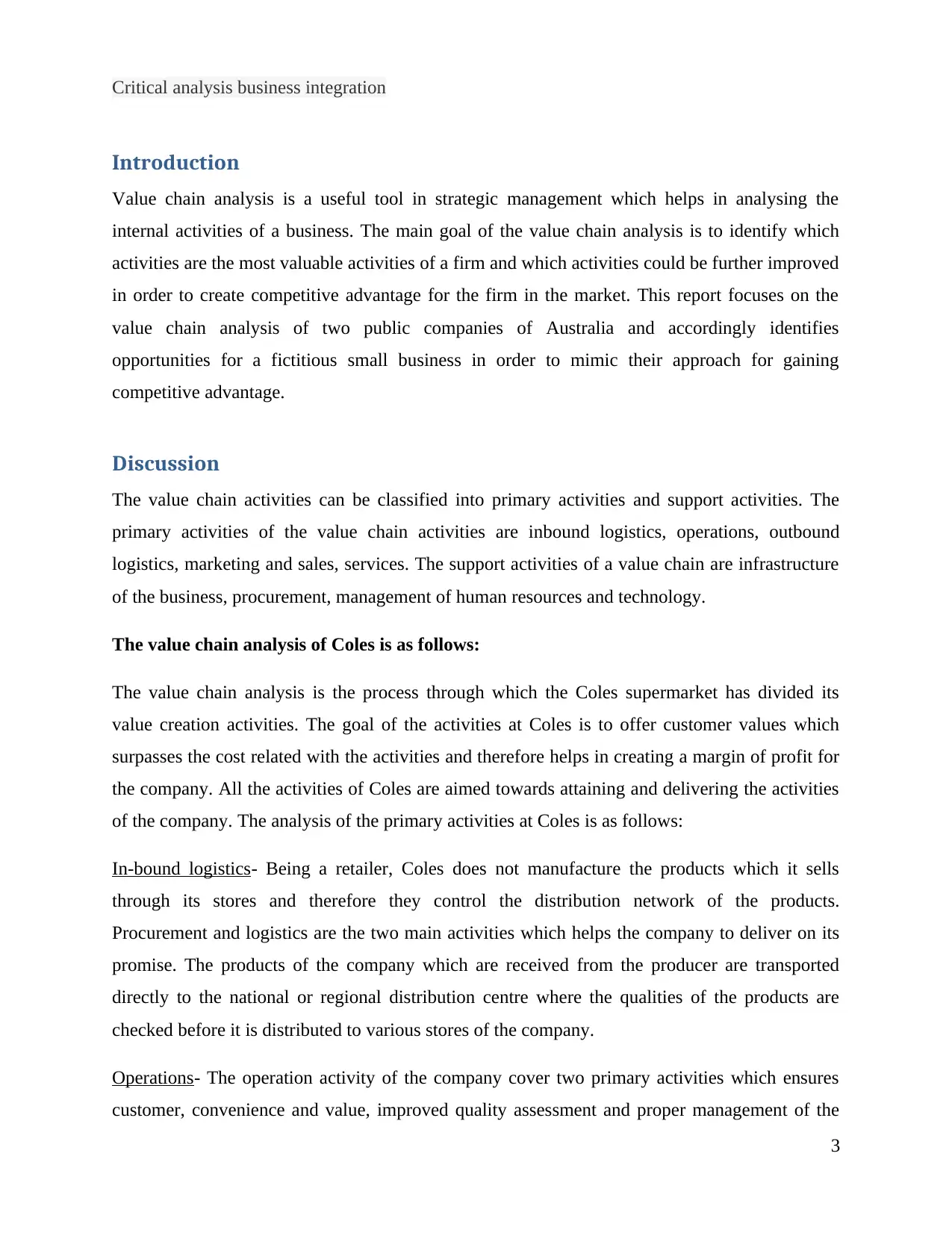
Critical analysis business integration
Introduction
Value chain analysis is a useful tool in strategic management which helps in analysing the
internal activities of a business. The main goal of the value chain analysis is to identify which
activities are the most valuable activities of a firm and which activities could be further improved
in order to create competitive advantage for the firm in the market. This report focuses on the
value chain analysis of two public companies of Australia and accordingly identifies
opportunities for a fictitious small business in order to mimic their approach for gaining
competitive advantage.
Discussion
The value chain activities can be classified into primary activities and support activities. The
primary activities of the value chain activities are inbound logistics, operations, outbound
logistics, marketing and sales, services. The support activities of a value chain are infrastructure
of the business, procurement, management of human resources and technology.
The value chain analysis of Coles is as follows:
The value chain analysis is the process through which the Coles supermarket has divided its
value creation activities. The goal of the activities at Coles is to offer customer values which
surpasses the cost related with the activities and therefore helps in creating a margin of profit for
the company. All the activities of Coles are aimed towards attaining and delivering the activities
of the company. The analysis of the primary activities at Coles is as follows:
In-bound logistics- Being a retailer, Coles does not manufacture the products which it sells
through its stores and therefore they control the distribution network of the products.
Procurement and logistics are the two main activities which helps the company to deliver on its
promise. The products of the company which are received from the producer are transported
directly to the national or regional distribution centre where the qualities of the products are
checked before it is distributed to various stores of the company.
Operations- The operation activity of the company cover two primary activities which ensures
customer, convenience and value, improved quality assessment and proper management of the
3
Introduction
Value chain analysis is a useful tool in strategic management which helps in analysing the
internal activities of a business. The main goal of the value chain analysis is to identify which
activities are the most valuable activities of a firm and which activities could be further improved
in order to create competitive advantage for the firm in the market. This report focuses on the
value chain analysis of two public companies of Australia and accordingly identifies
opportunities for a fictitious small business in order to mimic their approach for gaining
competitive advantage.
Discussion
The value chain activities can be classified into primary activities and support activities. The
primary activities of the value chain activities are inbound logistics, operations, outbound
logistics, marketing and sales, services. The support activities of a value chain are infrastructure
of the business, procurement, management of human resources and technology.
The value chain analysis of Coles is as follows:
The value chain analysis is the process through which the Coles supermarket has divided its
value creation activities. The goal of the activities at Coles is to offer customer values which
surpasses the cost related with the activities and therefore helps in creating a margin of profit for
the company. All the activities of Coles are aimed towards attaining and delivering the activities
of the company. The analysis of the primary activities at Coles is as follows:
In-bound logistics- Being a retailer, Coles does not manufacture the products which it sells
through its stores and therefore they control the distribution network of the products.
Procurement and logistics are the two main activities which helps the company to deliver on its
promise. The products of the company which are received from the producer are transported
directly to the national or regional distribution centre where the qualities of the products are
checked before it is distributed to various stores of the company.
Operations- The operation activity of the company cover two primary activities which ensures
customer, convenience and value, improved quality assessment and proper management of the
3
⊘ This is a preview!⊘
Do you want full access?
Subscribe today to unlock all pages.

Trusted by 1+ million students worldwide
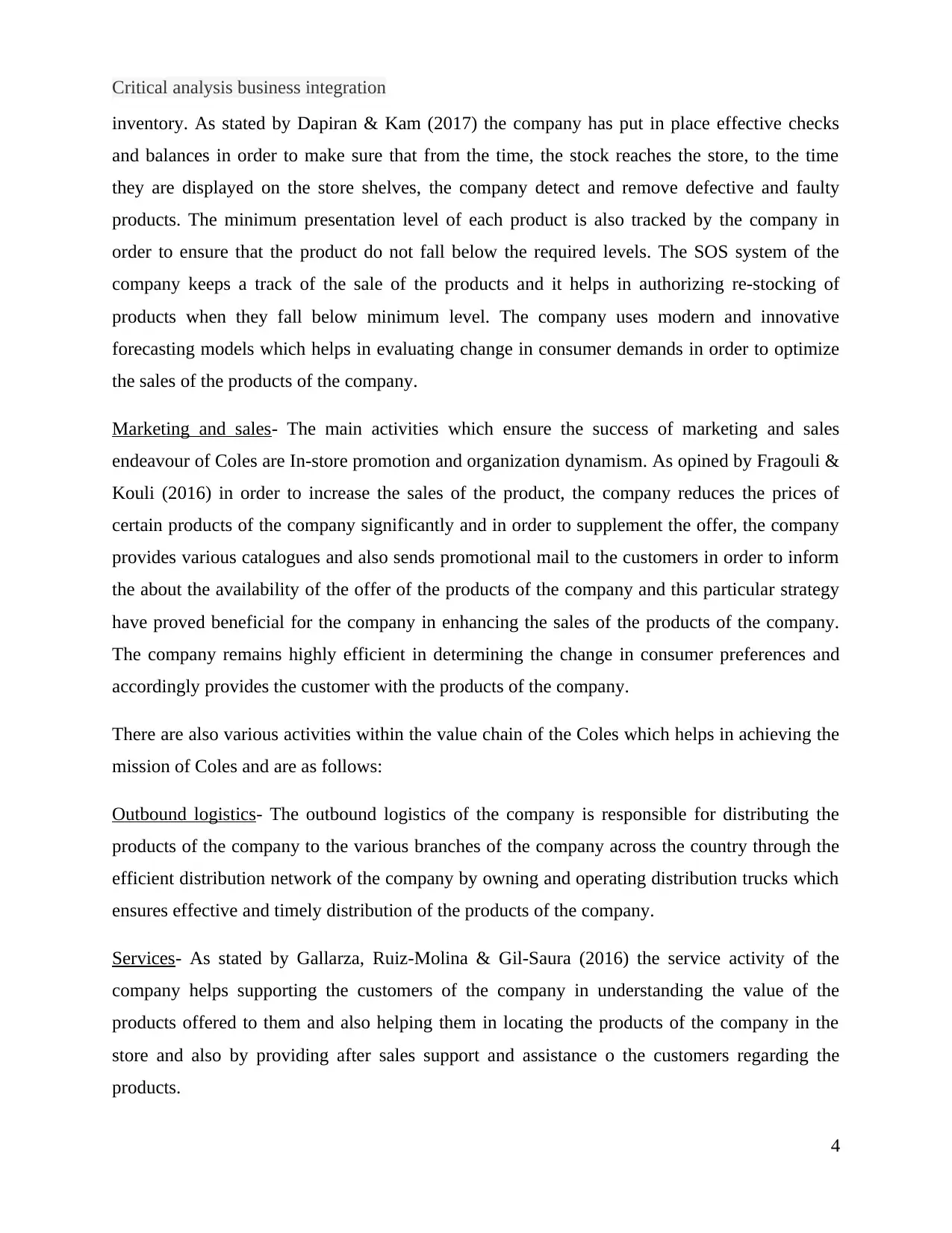
Critical analysis business integration
inventory. As stated by Dapiran & Kam (2017) the company has put in place effective checks
and balances in order to make sure that from the time, the stock reaches the store, to the time
they are displayed on the store shelves, the company detect and remove defective and faulty
products. The minimum presentation level of each product is also tracked by the company in
order to ensure that the product do not fall below the required levels. The SOS system of the
company keeps a track of the sale of the products and it helps in authorizing re-stocking of
products when they fall below minimum level. The company uses modern and innovative
forecasting models which helps in evaluating change in consumer demands in order to optimize
the sales of the products of the company.
Marketing and sales- The main activities which ensure the success of marketing and sales
endeavour of Coles are In-store promotion and organization dynamism. As opined by Fragouli &
Kouli (2016) in order to increase the sales of the product, the company reduces the prices of
certain products of the company significantly and in order to supplement the offer, the company
provides various catalogues and also sends promotional mail to the customers in order to inform
the about the availability of the offer of the products of the company and this particular strategy
have proved beneficial for the company in enhancing the sales of the products of the company.
The company remains highly efficient in determining the change in consumer preferences and
accordingly provides the customer with the products of the company.
There are also various activities within the value chain of the Coles which helps in achieving the
mission of Coles and are as follows:
Outbound logistics- The outbound logistics of the company is responsible for distributing the
products of the company to the various branches of the company across the country through the
efficient distribution network of the company by owning and operating distribution trucks which
ensures effective and timely distribution of the products of the company.
Services- As stated by Gallarza, Ruiz-Molina & Gil-Saura (2016) the service activity of the
company helps supporting the customers of the company in understanding the value of the
products offered to them and also helping them in locating the products of the company in the
store and also by providing after sales support and assistance o the customers regarding the
products.
4
inventory. As stated by Dapiran & Kam (2017) the company has put in place effective checks
and balances in order to make sure that from the time, the stock reaches the store, to the time
they are displayed on the store shelves, the company detect and remove defective and faulty
products. The minimum presentation level of each product is also tracked by the company in
order to ensure that the product do not fall below the required levels. The SOS system of the
company keeps a track of the sale of the products and it helps in authorizing re-stocking of
products when they fall below minimum level. The company uses modern and innovative
forecasting models which helps in evaluating change in consumer demands in order to optimize
the sales of the products of the company.
Marketing and sales- The main activities which ensure the success of marketing and sales
endeavour of Coles are In-store promotion and organization dynamism. As opined by Fragouli &
Kouli (2016) in order to increase the sales of the product, the company reduces the prices of
certain products of the company significantly and in order to supplement the offer, the company
provides various catalogues and also sends promotional mail to the customers in order to inform
the about the availability of the offer of the products of the company and this particular strategy
have proved beneficial for the company in enhancing the sales of the products of the company.
The company remains highly efficient in determining the change in consumer preferences and
accordingly provides the customer with the products of the company.
There are also various activities within the value chain of the Coles which helps in achieving the
mission of Coles and are as follows:
Outbound logistics- The outbound logistics of the company is responsible for distributing the
products of the company to the various branches of the company across the country through the
efficient distribution network of the company by owning and operating distribution trucks which
ensures effective and timely distribution of the products of the company.
Services- As stated by Gallarza, Ruiz-Molina & Gil-Saura (2016) the service activity of the
company helps supporting the customers of the company in understanding the value of the
products offered to them and also helping them in locating the products of the company in the
store and also by providing after sales support and assistance o the customers regarding the
products.
4
Paraphrase This Document
Need a fresh take? Get an instant paraphrase of this document with our AI Paraphraser
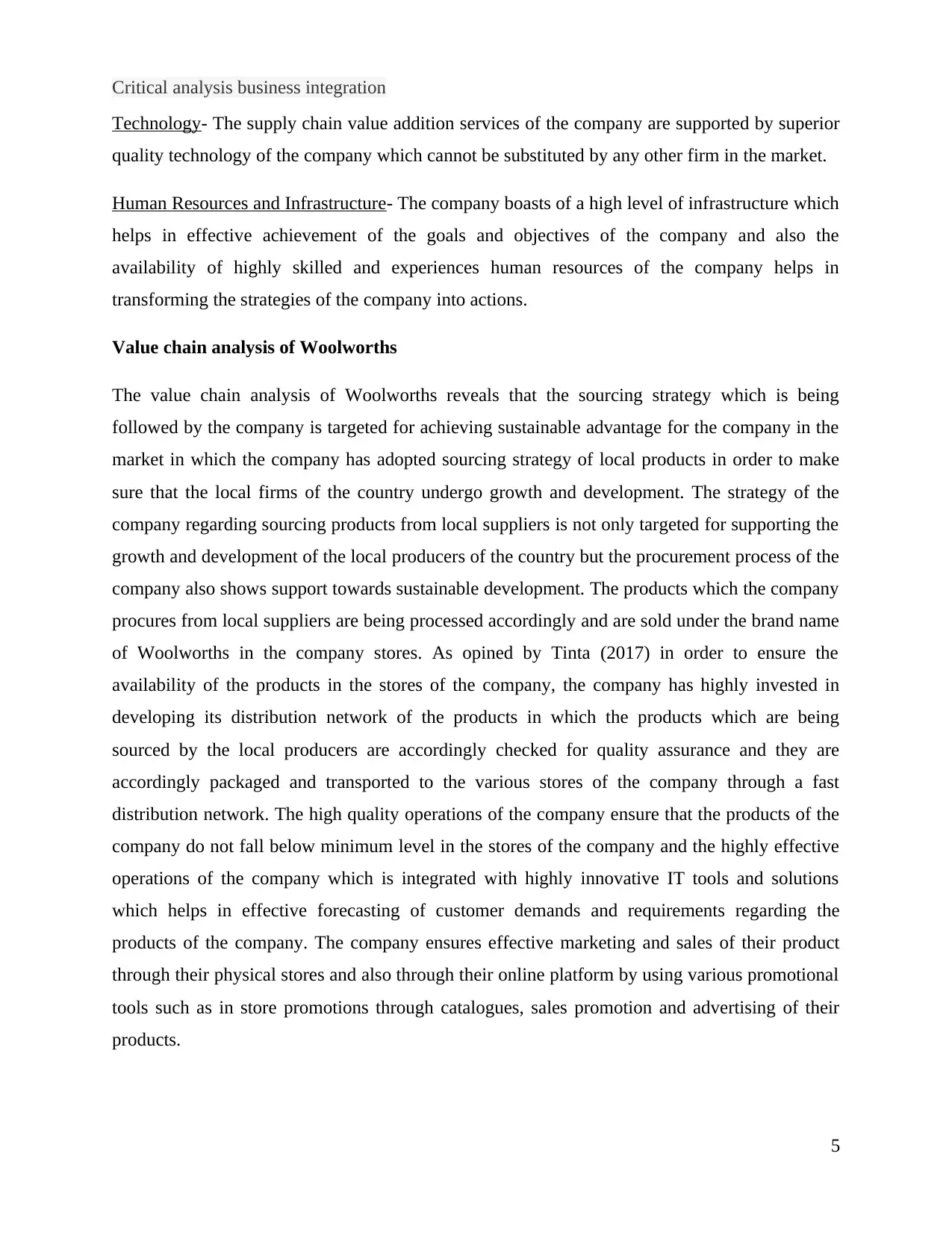
Critical analysis business integration
Technology- The supply chain value addition services of the company are supported by superior
quality technology of the company which cannot be substituted by any other firm in the market.
Human Resources and Infrastructure- The company boasts of a high level of infrastructure which
helps in effective achievement of the goals and objectives of the company and also the
availability of highly skilled and experiences human resources of the company helps in
transforming the strategies of the company into actions.
Value chain analysis of Woolworths
The value chain analysis of Woolworths reveals that the sourcing strategy which is being
followed by the company is targeted for achieving sustainable advantage for the company in the
market in which the company has adopted sourcing strategy of local products in order to make
sure that the local firms of the country undergo growth and development. The strategy of the
company regarding sourcing products from local suppliers is not only targeted for supporting the
growth and development of the local producers of the country but the procurement process of the
company also shows support towards sustainable development. The products which the company
procures from local suppliers are being processed accordingly and are sold under the brand name
of Woolworths in the company stores. As opined by Tinta (2017) in order to ensure the
availability of the products in the stores of the company, the company has highly invested in
developing its distribution network of the products in which the products which are being
sourced by the local producers are accordingly checked for quality assurance and they are
accordingly packaged and transported to the various stores of the company through a fast
distribution network. The high quality operations of the company ensure that the products of the
company do not fall below minimum level in the stores of the company and the highly effective
operations of the company which is integrated with highly innovative IT tools and solutions
which helps in effective forecasting of customer demands and requirements regarding the
products of the company. The company ensures effective marketing and sales of their product
through their physical stores and also through their online platform by using various promotional
tools such as in store promotions through catalogues, sales promotion and advertising of their
products.
5
Technology- The supply chain value addition services of the company are supported by superior
quality technology of the company which cannot be substituted by any other firm in the market.
Human Resources and Infrastructure- The company boasts of a high level of infrastructure which
helps in effective achievement of the goals and objectives of the company and also the
availability of highly skilled and experiences human resources of the company helps in
transforming the strategies of the company into actions.
Value chain analysis of Woolworths
The value chain analysis of Woolworths reveals that the sourcing strategy which is being
followed by the company is targeted for achieving sustainable advantage for the company in the
market in which the company has adopted sourcing strategy of local products in order to make
sure that the local firms of the country undergo growth and development. The strategy of the
company regarding sourcing products from local suppliers is not only targeted for supporting the
growth and development of the local producers of the country but the procurement process of the
company also shows support towards sustainable development. The products which the company
procures from local suppliers are being processed accordingly and are sold under the brand name
of Woolworths in the company stores. As opined by Tinta (2017) in order to ensure the
availability of the products in the stores of the company, the company has highly invested in
developing its distribution network of the products in which the products which are being
sourced by the local producers are accordingly checked for quality assurance and they are
accordingly packaged and transported to the various stores of the company through a fast
distribution network. The high quality operations of the company ensure that the products of the
company do not fall below minimum level in the stores of the company and the highly effective
operations of the company which is integrated with highly innovative IT tools and solutions
which helps in effective forecasting of customer demands and requirements regarding the
products of the company. The company ensures effective marketing and sales of their product
through their physical stores and also through their online platform by using various promotional
tools such as in store promotions through catalogues, sales promotion and advertising of their
products.
5
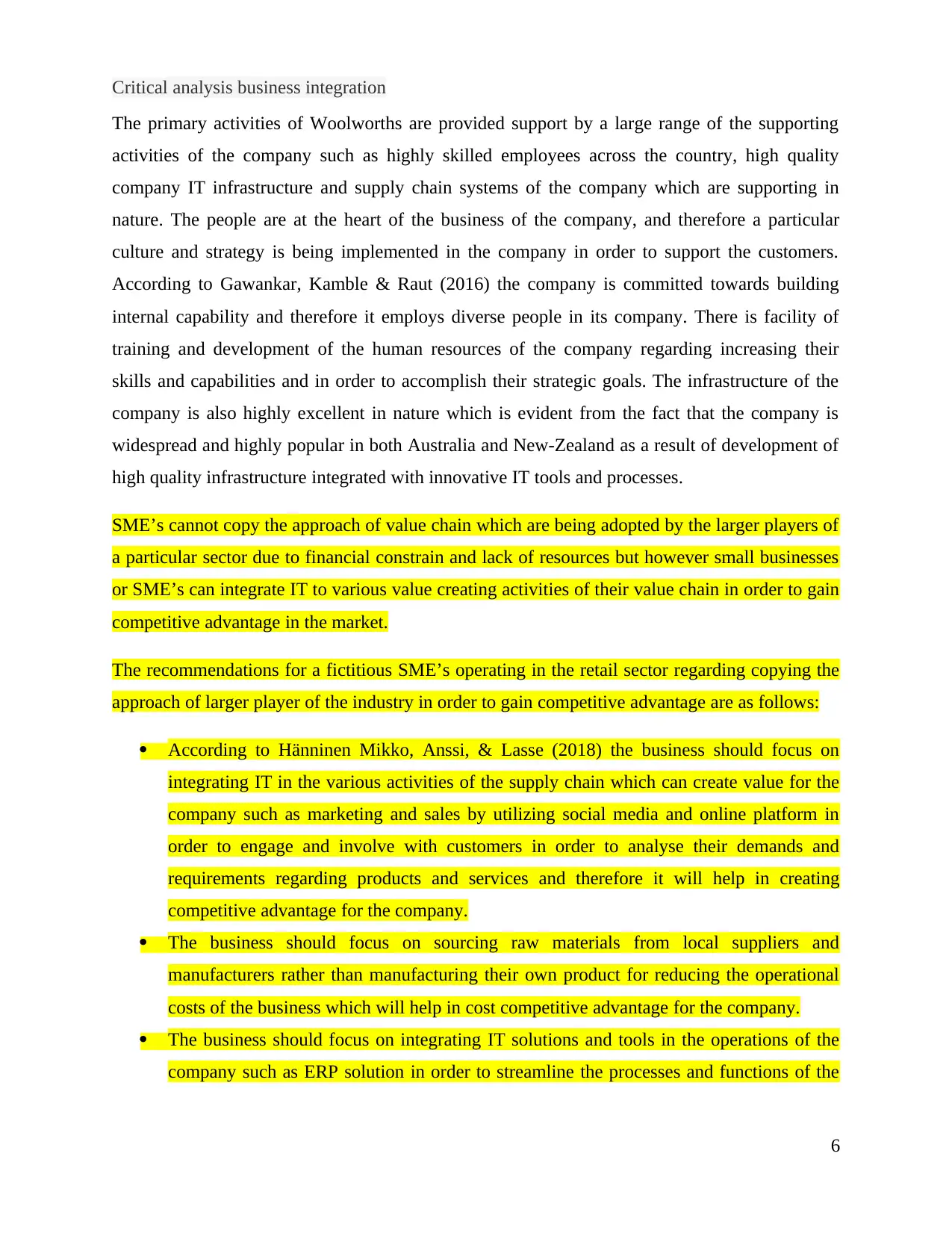
Critical analysis business integration
The primary activities of Woolworths are provided support by a large range of the supporting
activities of the company such as highly skilled employees across the country, high quality
company IT infrastructure and supply chain systems of the company which are supporting in
nature. The people are at the heart of the business of the company, and therefore a particular
culture and strategy is being implemented in the company in order to support the customers.
According to Gawankar, Kamble & Raut (2016) the company is committed towards building
internal capability and therefore it employs diverse people in its company. There is facility of
training and development of the human resources of the company regarding increasing their
skills and capabilities and in order to accomplish their strategic goals. The infrastructure of the
company is also highly excellent in nature which is evident from the fact that the company is
widespread and highly popular in both Australia and New-Zealand as a result of development of
high quality infrastructure integrated with innovative IT tools and processes.
SME’s cannot copy the approach of value chain which are being adopted by the larger players of
a particular sector due to financial constrain and lack of resources but however small businesses
or SME’s can integrate IT to various value creating activities of their value chain in order to gain
competitive advantage in the market.
The recommendations for a fictitious SME’s operating in the retail sector regarding copying the
approach of larger player of the industry in order to gain competitive advantage are as follows:
According to Hänninen Mikko, Anssi, & Lasse (2018) the business should focus on
integrating IT in the various activities of the supply chain which can create value for the
company such as marketing and sales by utilizing social media and online platform in
order to engage and involve with customers in order to analyse their demands and
requirements regarding products and services and therefore it will help in creating
competitive advantage for the company.
The business should focus on sourcing raw materials from local suppliers and
manufacturers rather than manufacturing their own product for reducing the operational
costs of the business which will help in cost competitive advantage for the company.
The business should focus on integrating IT solutions and tools in the operations of the
company such as ERP solution in order to streamline the processes and functions of the
6
The primary activities of Woolworths are provided support by a large range of the supporting
activities of the company such as highly skilled employees across the country, high quality
company IT infrastructure and supply chain systems of the company which are supporting in
nature. The people are at the heart of the business of the company, and therefore a particular
culture and strategy is being implemented in the company in order to support the customers.
According to Gawankar, Kamble & Raut (2016) the company is committed towards building
internal capability and therefore it employs diverse people in its company. There is facility of
training and development of the human resources of the company regarding increasing their
skills and capabilities and in order to accomplish their strategic goals. The infrastructure of the
company is also highly excellent in nature which is evident from the fact that the company is
widespread and highly popular in both Australia and New-Zealand as a result of development of
high quality infrastructure integrated with innovative IT tools and processes.
SME’s cannot copy the approach of value chain which are being adopted by the larger players of
a particular sector due to financial constrain and lack of resources but however small businesses
or SME’s can integrate IT to various value creating activities of their value chain in order to gain
competitive advantage in the market.
The recommendations for a fictitious SME’s operating in the retail sector regarding copying the
approach of larger player of the industry in order to gain competitive advantage are as follows:
According to Hänninen Mikko, Anssi, & Lasse (2018) the business should focus on
integrating IT in the various activities of the supply chain which can create value for the
company such as marketing and sales by utilizing social media and online platform in
order to engage and involve with customers in order to analyse their demands and
requirements regarding products and services and therefore it will help in creating
competitive advantage for the company.
The business should focus on sourcing raw materials from local suppliers and
manufacturers rather than manufacturing their own product for reducing the operational
costs of the business which will help in cost competitive advantage for the company.
The business should focus on integrating IT solutions and tools in the operations of the
company such as ERP solution in order to streamline the processes and functions of the
6
⊘ This is a preview!⊘
Do you want full access?
Subscribe today to unlock all pages.

Trusted by 1+ million students worldwide
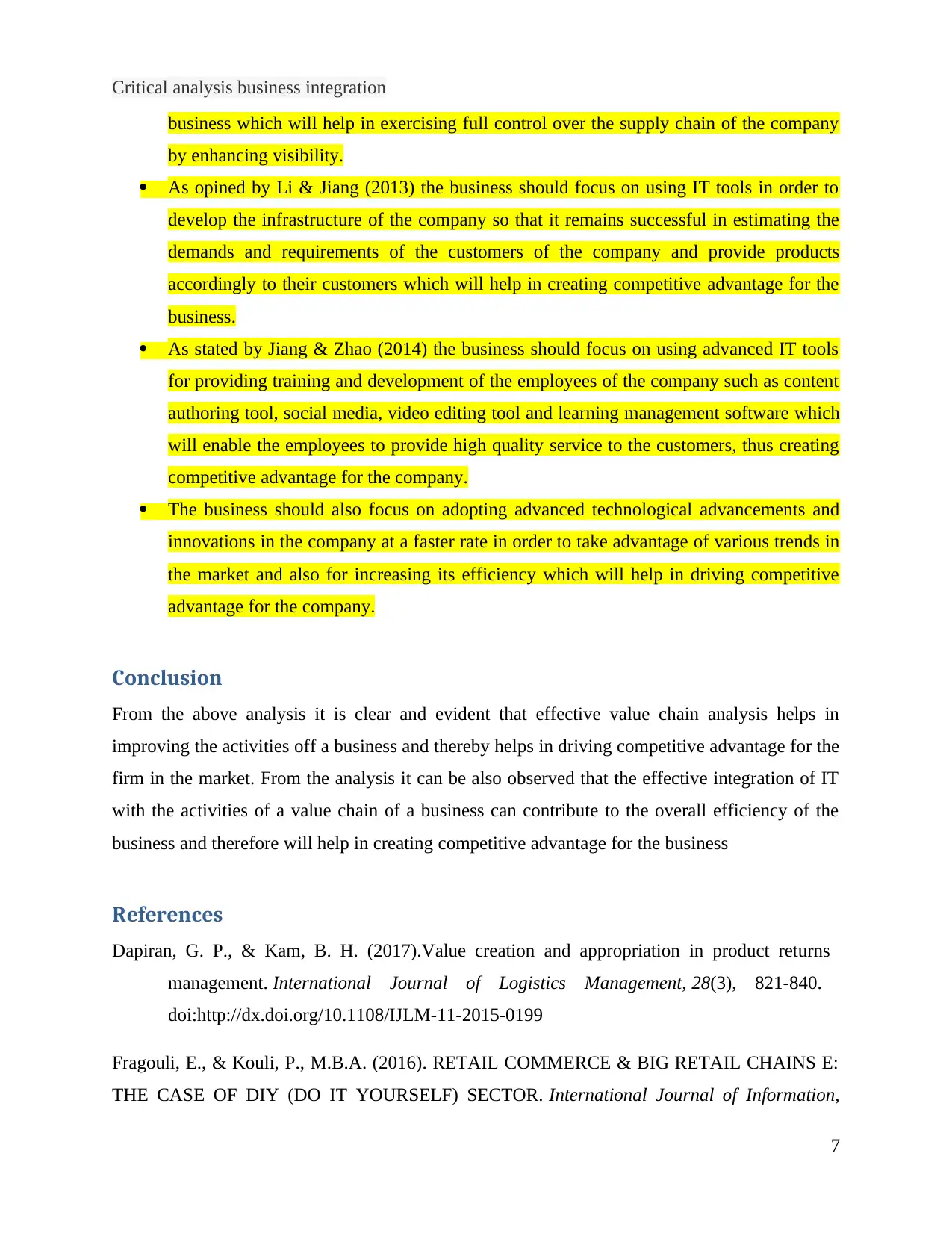
Critical analysis business integration
business which will help in exercising full control over the supply chain of the company
by enhancing visibility.
As opined by Li & Jiang (2013) the business should focus on using IT tools in order to
develop the infrastructure of the company so that it remains successful in estimating the
demands and requirements of the customers of the company and provide products
accordingly to their customers which will help in creating competitive advantage for the
business.
As stated by Jiang & Zhao (2014) the business should focus on using advanced IT tools
for providing training and development of the employees of the company such as content
authoring tool, social media, video editing tool and learning management software which
will enable the employees to provide high quality service to the customers, thus creating
competitive advantage for the company.
The business should also focus on adopting advanced technological advancements and
innovations in the company at a faster rate in order to take advantage of various trends in
the market and also for increasing its efficiency which will help in driving competitive
advantage for the company.
Conclusion
From the above analysis it is clear and evident that effective value chain analysis helps in
improving the activities off a business and thereby helps in driving competitive advantage for the
firm in the market. From the analysis it can be also observed that the effective integration of IT
with the activities of a value chain of a business can contribute to the overall efficiency of the
business and therefore will help in creating competitive advantage for the business
References
Dapiran, G. P., & Kam, B. H. (2017).Value creation and appropriation in product returns
management. International Journal of Logistics Management, 28(3), 821-840.
doi:http://dx.doi.org/10.1108/IJLM-11-2015-0199
Fragouli, E., & Kouli, P., M.B.A. (2016). RETAIL COMMERCE & BIG RETAIL CHAINS E:
THE CASE OF DIY (DO IT YOURSELF) SECTOR. International Journal of Information,
7
business which will help in exercising full control over the supply chain of the company
by enhancing visibility.
As opined by Li & Jiang (2013) the business should focus on using IT tools in order to
develop the infrastructure of the company so that it remains successful in estimating the
demands and requirements of the customers of the company and provide products
accordingly to their customers which will help in creating competitive advantage for the
business.
As stated by Jiang & Zhao (2014) the business should focus on using advanced IT tools
for providing training and development of the employees of the company such as content
authoring tool, social media, video editing tool and learning management software which
will enable the employees to provide high quality service to the customers, thus creating
competitive advantage for the company.
The business should also focus on adopting advanced technological advancements and
innovations in the company at a faster rate in order to take advantage of various trends in
the market and also for increasing its efficiency which will help in driving competitive
advantage for the company.
Conclusion
From the above analysis it is clear and evident that effective value chain analysis helps in
improving the activities off a business and thereby helps in driving competitive advantage for the
firm in the market. From the analysis it can be also observed that the effective integration of IT
with the activities of a value chain of a business can contribute to the overall efficiency of the
business and therefore will help in creating competitive advantage for the business
References
Dapiran, G. P., & Kam, B. H. (2017).Value creation and appropriation in product returns
management. International Journal of Logistics Management, 28(3), 821-840.
doi:http://dx.doi.org/10.1108/IJLM-11-2015-0199
Fragouli, E., & Kouli, P., M.B.A. (2016). RETAIL COMMERCE & BIG RETAIL CHAINS E:
THE CASE OF DIY (DO IT YOURSELF) SECTOR. International Journal of Information,
7
Paraphrase This Document
Need a fresh take? Get an instant paraphrase of this document with our AI Paraphraser
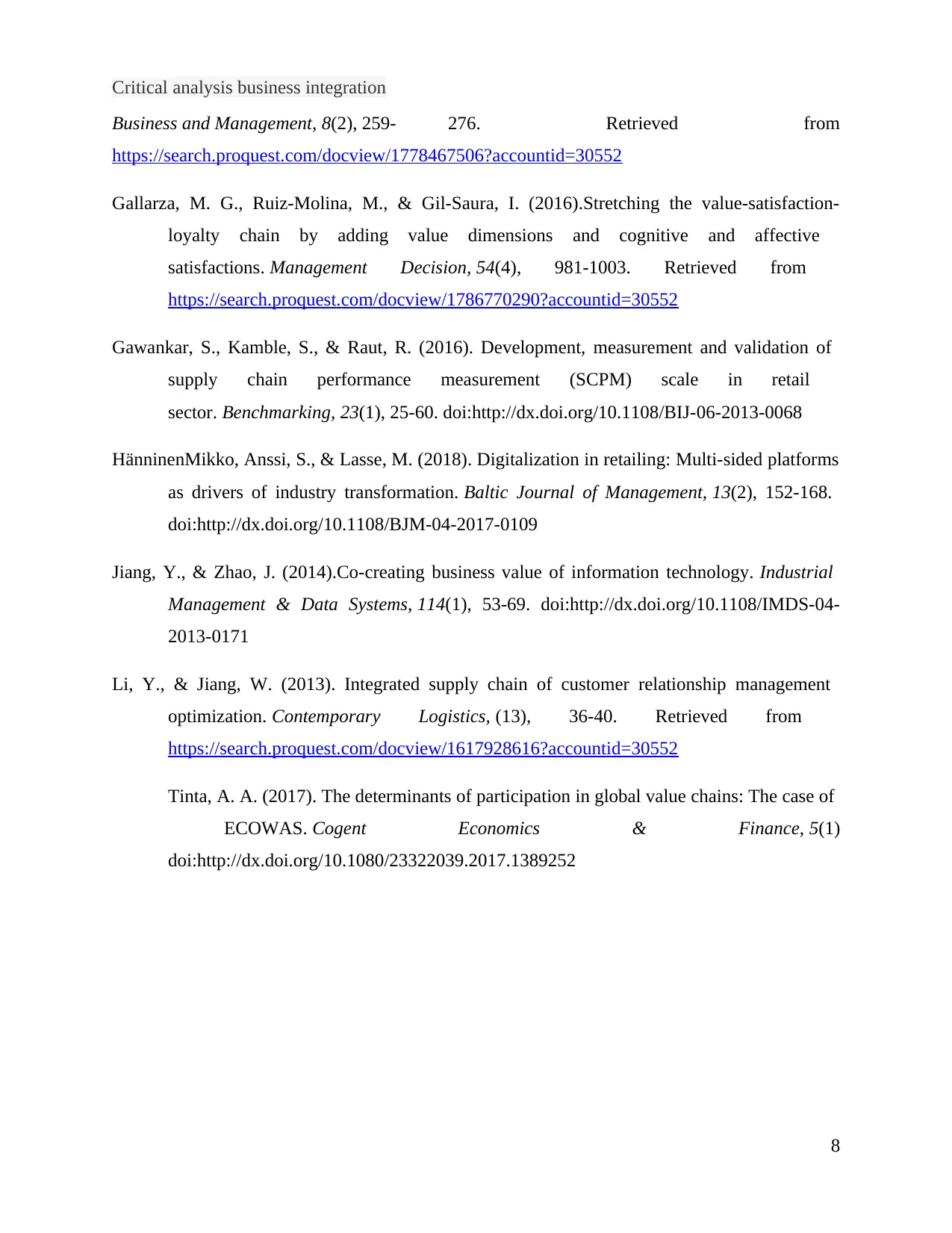
Critical analysis business integration
Business and Management, 8(2), 259- 276. Retrieved from
https://search.proquest.com/docview/1778467506?accountid=30552
Gallarza, M. G., Ruiz-Molina, M., & Gil-Saura, I. (2016).Stretching the value-satisfaction-
loyalty chain by adding value dimensions and cognitive and affective
satisfactions. Management Decision, 54(4), 981-1003. Retrieved from
https://search.proquest.com/docview/1786770290?accountid=30552
Gawankar, S., Kamble, S., & Raut, R. (2016). Development, measurement and validation of
supply chain performance measurement (SCPM) scale in retail
sector. Benchmarking, 23(1), 25-60. doi:http://dx.doi.org/10.1108/BIJ-06-2013-0068
HänninenMikko, Anssi, S., & Lasse, M. (2018). Digitalization in retailing: Multi-sided platforms
as drivers of industry transformation. Baltic Journal of Management, 13(2), 152-168.
doi:http://dx.doi.org/10.1108/BJM-04-2017-0109
Jiang, Y., & Zhao, J. (2014).Co-creating business value of information technology. Industrial
Management & Data Systems, 114(1), 53-69. doi:http://dx.doi.org/10.1108/IMDS-04-
2013-0171
Li, Y., & Jiang, W. (2013). Integrated supply chain of customer relationship management
optimization. Contemporary Logistics, (13), 36-40. Retrieved from
https://search.proquest.com/docview/1617928616?accountid=30552
Tinta, A. A. (2017). The determinants of participation in global value chains: The case of
ECOWAS. Cogent Economics & Finance, 5(1)
doi:http://dx.doi.org/10.1080/23322039.2017.1389252
8
Business and Management, 8(2), 259- 276. Retrieved from
https://search.proquest.com/docview/1778467506?accountid=30552
Gallarza, M. G., Ruiz-Molina, M., & Gil-Saura, I. (2016).Stretching the value-satisfaction-
loyalty chain by adding value dimensions and cognitive and affective
satisfactions. Management Decision, 54(4), 981-1003. Retrieved from
https://search.proquest.com/docview/1786770290?accountid=30552
Gawankar, S., Kamble, S., & Raut, R. (2016). Development, measurement and validation of
supply chain performance measurement (SCPM) scale in retail
sector. Benchmarking, 23(1), 25-60. doi:http://dx.doi.org/10.1108/BIJ-06-2013-0068
HänninenMikko, Anssi, S., & Lasse, M. (2018). Digitalization in retailing: Multi-sided platforms
as drivers of industry transformation. Baltic Journal of Management, 13(2), 152-168.
doi:http://dx.doi.org/10.1108/BJM-04-2017-0109
Jiang, Y., & Zhao, J. (2014).Co-creating business value of information technology. Industrial
Management & Data Systems, 114(1), 53-69. doi:http://dx.doi.org/10.1108/IMDS-04-
2013-0171
Li, Y., & Jiang, W. (2013). Integrated supply chain of customer relationship management
optimization. Contemporary Logistics, (13), 36-40. Retrieved from
https://search.proquest.com/docview/1617928616?accountid=30552
Tinta, A. A. (2017). The determinants of participation in global value chains: The case of
ECOWAS. Cogent Economics & Finance, 5(1)
doi:http://dx.doi.org/10.1080/23322039.2017.1389252
8
1 out of 8
Related Documents
Your All-in-One AI-Powered Toolkit for Academic Success.
+13062052269
info@desklib.com
Available 24*7 on WhatsApp / Email
![[object Object]](/_next/static/media/star-bottom.7253800d.svg)
Unlock your academic potential
Copyright © 2020–2025 A2Z Services. All Rights Reserved. Developed and managed by ZUCOL.





